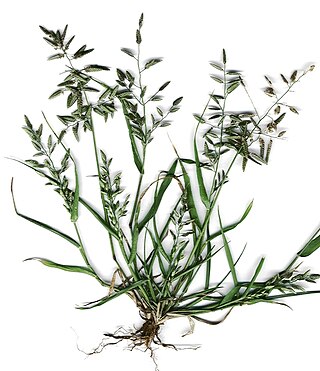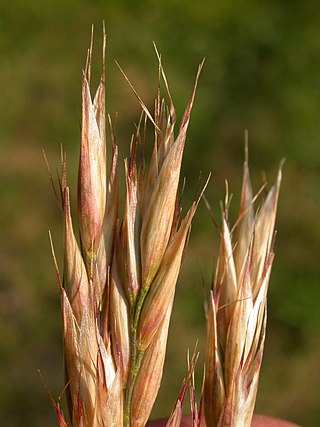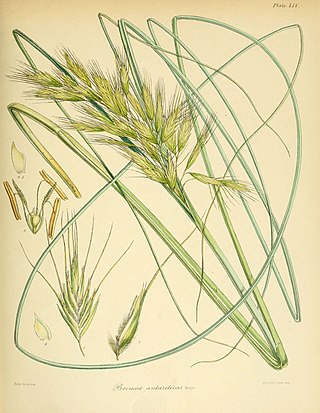
Eragrostis is a large and widespread genus of plants in the grass family, found in many countries on all inhabited continents and many islands.

The Indomalayan realm is one of the eight biogeographic realms. It extends across most of South and Southeast Asia and into the southern parts of East Asia.

Cortaderia is a genus of South American and Central American plants in the Poaceae grass family.

The New Caledonia rain forests are a terrestrial ecoregion, located in New Caledonia in the South Pacific. It is a tropical moist broadleaf forest ecoregion, part of the Australasian realm.

Panicum (panicgrass) is a large genus of about 450 species of Poaceae grasses native throughout the tropical regions of the world, with a few species extending into the northern temperate zone. They are often large, annual or perennial grasses, growing to 1–3 m (3–10 ft) tall.

Danthonia is a genus of Eurasian, North African, and American plants in the grass family. Members of this genus are sometimes referred to as oatgrass, but that common name is not restricted to this genus. Other common names include heathgrass and wallaby grass. Australian species have since been reclassified into the genus Rytidosperma.

The Lord Howe long-eared bat was a vespertilionid bat known only by a single specimen, a skull found on Lord Howe Island in 1972. A mammalian insectivorous species resembling the long-eared Nyctophilus, with an elongated head that is comparatively larger, about which almost nothing is known. The bat may have been casually observed in flight during the twentieth century, but is likely to have become extinct since the island's discovery and occupation. The demise of N. howensis is possibly the result of shipwrecked rats and the owls introduced to control them.

Sporobolus is a nearly cosmopolitan genus of plants in the grass family. The name Sporobolus means "seed-thrower", and is derived from Ancient Greek word σπόρος (spóros), meaning "seed", and the root of βάλλειν (bállein) "to throw", referring to the dispersion of seeds. Members of the genus are usually called dropseeds or sacaton grasses. They are typical prairie and savanna plants, occurring in other types of open habitat in warmer climates. At least one species is threatened with extinction, and another is extinct.

The Ontong Java flying fox is a species of flying fox in the family Pteropodidae. It is endemic to the Ontong Java Atoll in the Solomon Islands. Its natural habitats are subtropical or tropical dry forests and subtropical or tropical swamps. It was classified as "Critically Endangered" in 2021 by the IUCN. Its confirmed range extends only over small islands, all of which are near to sea level. It is threatened by rising sea levels.

Chionochloa is a genus of tussock grass in the family Poaceae, found primarily in New Zealand with one known species in New Guinea and another on Lord Howe Island. Some of the species are referred to as snowgrass.

Tussock grasses or bunch grasses are a group of grass species in the family Poaceae. They usually grow as singular plants in clumps, tufts, hummocks, or bunches, rather than forming a sod or lawn, in meadows, grasslands, and prairies. As perennial plants, most species live more than one season. Tussock grasses are often found as forage in pastures and ornamental grasses in gardens.

Chionochloa rubra, known commonly as red tussock grass, is a species of tussock grass in the grass family, endemic to New Zealand.

Tussock grasslands form expansive and distinctive landscapes in the South Island and, to a lesser extent, in the Central Plateau region of the North Island of New Zealand. Most of the plants referred to as tussocks are in the genera Chionochloa, Festuca, and Poa, also Carex.

The flora of Australia comprises a vast assemblage of plant species estimated to over 21,000 vascular and 14,000 non-vascular plants, 250,000 species of fungi and over 3,000 lichens. The flora has strong affinities with the flora of Gondwana, and below the family level has a highly endemic angiosperm flora whose diversity was shaped by the effects of continental drift and climate change since the Cretaceous. Prominent features of the Australian flora are adaptations to aridity and fire which include scleromorphy and serotiny. These adaptations are common in species from the large and well-known families Proteaceae (Banksia), Myrtaceae, and Fabaceae.

Zealandia pustulata is a species of fern native to eastern Australia and New Zealand. It is commonly referred to as kangaroo fern because of its mature leaves tend to resemble the shape of a kangaroo foot. It is also referred to as hound's tongue, and as kōwaowao and pāraharaha in Māori.

Chionochloa flavicans is a species of plant in the grass family, endemic to New Zealand.

Chionochloa antarctica is a species of grass, endemic to the Auckland and Campbell Islands.

Dracophyllum fitzgeraldii, commonly known as the Fitzgeraldii tree or Fitzgerald tree, is a flowering plant in the family Ericaceae. It is endemic to Lord Howe Island, though its closest relatives are species native to northern Queensland and to New Caledonia.
Exocarpos homalocladus, commonly known as the grass tree, is a flowering plant in the sandalwood family. The specific epithet comes from the Greek homalos (“flat”) and clados, with reference to the structure of the plant.

Chionochloa rigida, known commonly as narrow-leaved snow tussock and by its Māori name wī kura, is a species of tussock grass endemic to New Zealand. Two subspecies are recognised, including Chionochloa rigida rigida and Chionochloa rigida amara.

















